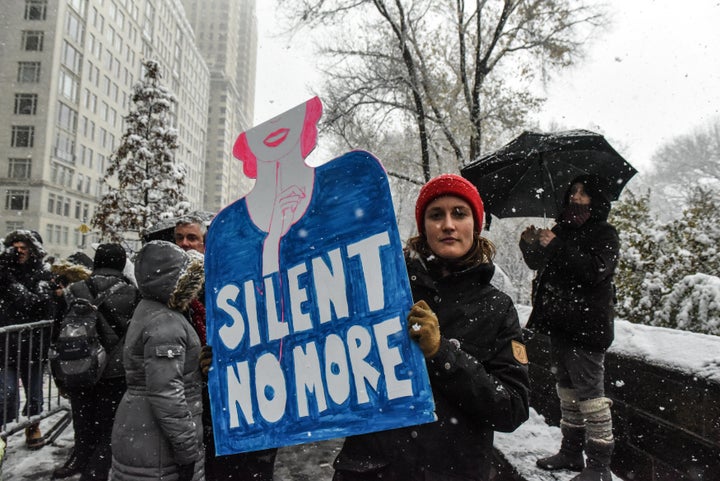
A torrent of sexual harassment revelations has launched a long-overdue discussion of a perennial social plague afflicting countless women, girls, and boys. (Adult men are occasionally victimized as well). We have many courageous women and the #MeToo movement to thank for bringing this issue out of the shadows and into the open where it is being discussed among friends, by policymakers, at workplaces, and in our families and other social milieu.
The quality of this long-deferred public debate will be depends on at least three things: (1) how accurately we identify the causes of sexual harassment; (2) how carefully we distinguish among the distinct behaviors now lumped under this portmanteau phrase; and (3) how wisely we design measures to assess, punish, and prevent those behaviors.
Causes. Sexual harassment has several causes. The first is lust, sheer animal attractions between men and women. Lust is inevitable (for psycho-biochemical reasons), pleasurable (if indulged in mutually desired and gratifying ways), and necessary (to perpetuate our species). But our grotesquely sexualized popular culture dangerously stokes and magnifies this lust. Second, a pervasive power imbalance converts this lust into opportunities for exploitative, almost onanistic self-gratification by aggressive, narcissistic men against more vulnerable women. Third, harassment can reflect genuine misunderstandings, mixed signals, interpersonal clumsiness, and loss of ordinary self-control due to excessive drinking, substance abuse, and other factors. These causes cannot be eliminated but can be ameliorated ― as crime, poverty, and teenage pregnancy have been.
Drawing distinctions. Much public discussion of sexual harassment suggests that it is all of a piece and deserves undifferentiated condemnation and punishment. But it isn’t this simple. Many women affirm what should be obvious: the term is being applied to a variety of behaviors and situations whose moral offense and harmful effects are quite different. Yet New York Times columnist Brett Stephens and actor Matt Damon have been pilloried for making the same point.
The law already does some of this line-drawing. Centuries of legislative and judicial decisions have elaborated important defining concepts like force, battery, consent, autonomy, and reasonable fear for one’s bodily or psychic integrity. Sexual assault, so defined, is both a crime subject to penal sanctions, and a tort subject to monetary sanctions. These laws can deter and punish harassment but much of it is neither criminal nor tortious and so goes unremedied. More line-drawing is essential.
Kathleen Kelley Reardon, a management professor and blogger, recently offered guidance, describing a “spectrum of sexual misconduct at work” ranging from the inoffensive to the “egregious.” She deems “common off the cuff compliments on such things as hair style and dress” to be non-offensive. But this category should also include sarcasm, digs, and words that hurt people’s feelings. In our free-wheeling society, in which we interact with people whom we know only superficially, our exchanges need breathing space and spontaneity. We should endeavor not to offend, of course, but in the course of lively exchanges, our comments and intentions can easily be misunderstood and resented. The offended person should candidly tell the speaker that she objects, and why. Although this might deepen the resentment, an exchange that exhumes the real individuals buried beneath the superficial chit-chat might instead yield more rewarding interactions. Context matters.
Reardon next lists “awkward/mildly offensive” comments exemplified by “comments on gender differences.” But here too, she condemns too broadly. While legal and social equality for women and sexual minorities advances, many gender differences persist, deeply rooted in biology and culture. These differences enrich our lives and our experiences of one another. We should not be discouraged from discussing them, even if some comments are unwelcome to those convinced that differences are “merely” constructs of a deeply unequal society. Jokes about gender differences may be crude or unfunny but even annoying jokes can contain some insight about our relationships – for example, that men and women often do see things differently. If one is offended, one should inform the speaker that it’s not funny or even walk out.
More offensive, according to Reardon, are acts like “holding a woman’s arm while talking,” “uninvited hugs,” “patronizing/dismissive/exclusionary behavior toward women,” and “implying or stating that women are distracted by family.” Even here, reasonable people may disagree. The meaning of such acts largely depends, again, on their context, which is often ambiguous. How is one to know whether a friendly hug of a woman whom one has met before is “invited” or not? Inquiring would destroy the gesture’s warmth and spontaneity. Remaining aloof is safer but such common interactions are simply too variable to be regulated unless they are genuinely fearful or oppressive, which they seldom are.
Does Reardon’s norm against “exclusionary behavior” condemn social gatherings in which the men and women commonly talk among their gender peers, presumably out of choice? And why is it offensive to suggest that a woman is distracted by her family when research clearly shows that she does in fact end up spending much more time than her husband in managing their children? Again, Reardon’s admirable wish to avoid demeaning or sidetracking women gives too little weight to context. Thus we should view such a comment by a job interviewer (offensive and possibly illegal) differently than one by a neighbor or garrulous massage therapist. Even more serious offenses, for Reardon, are comments that “devalue” women – denigrating them as a group or making demeaning reference to their physical attributes. Such comments may be crude, thoughtless, and insulting, but the remedy for the offended should be to refute and censure the comment rather than trying to silence the commenter by formally sanctioning his unwanted speech. A worrisome analogy occurs on too many campuses where opponents of controversial ideas try to censor them by insisting that they are pained by being exposed to them. Our line-drawing, then, should discourage offensiveness while not encouraging hyper-sensitivity and undue umbrage.
Some of Reardon’s examples of “evident sexual misconduct” ― grabbing, rude patting, and unwelcome holding or kissing of a woman; describing her as a “slut” or “frigid;” and accusing her of using her gender to advance her career ― are not merely objectionable; they could well constitute a tortious assault, battery, or defamation. But her catalog of misconduct goes further. It condemns looking a woman up and down “in a sexually suggestive manner.” Depending on what that phrase means, it might condemn admiring glances that – if they go no farther ― do no real harm. She would also punish a man who ignores a woman’s expressed disinterest in a relationship and continues to “hassle” her. Depending on what “hassle” means in a specific context, this may either protect the woman or condemn a kind of male persistence that has yielded many happy relationships.
Reardon’s more “egregious sexual misconduct” examples are already criminal, tortious, or both – and rightly so. But the real challenge concerns whether and how we should regulate aggressive but non-violent conduct and less egregious behavior that still causes fear and offense. Here, line-drawing is much more challenging. People interact in infinitely varied ways and assess signals and meanings very differently. Again, context and intent matter. Most social norms are opaque and informally enforced. Safety and security are at stake, but so are other values. In this realm, then, adopting hard-and-fast rules is less desirable than clarifying social expectations about how we should behave in various situations, how we should communicate our desires, and how individuals and institutions should respond when those norms are allegedly violated.
Procedures. Consider how educational institutions have handled sexual harassment claims. We see that even benign, well-resourced schools are caught in a cultural crossfire. Their efforts to handle these disputes with campus-specific procedures and standards founder on the high stakes. Accusers demand protection and justice. The accused, facing the prospect of expulsion and criminal prosecution, demand rigorous procedural safeguards. Onlookers - other students, alumni, civil rights officials, ideologues of left and right, and the media ― have their own fish to fry and are ready to pounce on these disputes however they are resolved. No one seems satisfied by the schools’ makeshift arrangements.
Law enforcement agencies, for all their limitations, are far better equipped to handle these difficult disputes. Schools, workplaces, and other institutions should not adjudicate sexual harassment claims but should instead limit their role to determining whether the accuser has alleged facts that, if true, could constitute legally actionable harassment. If so, the institution should advise the accuser to consider taking her case to the police and obtaining a lawyer. It should release as little identifying information as possible until the matter is adjudicated or otherwise resolved. Judicial rulings, official pressures, and public demands have already strengthened institutions’ existing incentives to prevent harassment, but more prevention efforts can surely be undertaken. Importantly, they can punish the heavy drinking and drug use that fuel much harassment and can denounce the hook-up culture. Law enforcement agencies should look to the best practices of other such agencies, which include allocating more resources to informal counseling of fearful accusers and improving fact-finding processes.
Harms to the career, dignitary, and security interests of harassment victims are hard to quantify or even identify in individual cases. Remedies for victims seem arbitrary. Most likely receive nothing, not even an apology. Accusers may suffer informal blacklisting. Yet some others get payoffs that seem far higher than the actual harm they could have suffered, as when Bill O’Reilly paid Lis Wiehl $32 million. We should clarify what we mean by non-criminal sexual harassment, which procedures are fair and effective, and then ensure that both harassers and victims get what they deserve.
